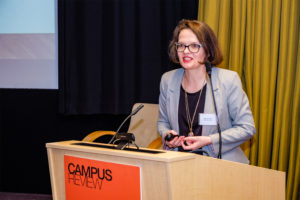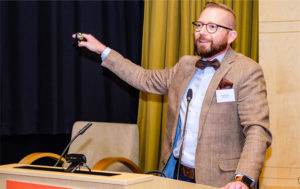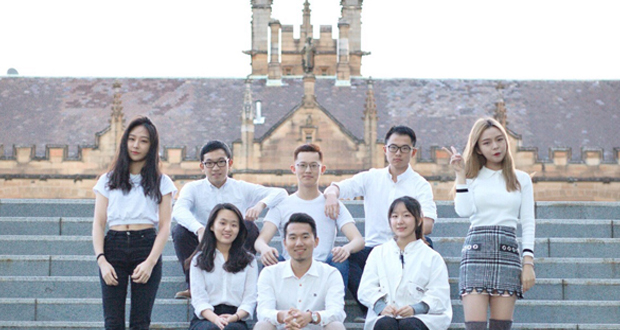China, India, and beyond
Did you know that 25 years ago, Australia hosted more international students from Indonesia, Taiwan, Thailand, Japan and the UK than it does today?
That could be set to change with the advent of several new free trade agreements (FTAs). Gabriele Suder is an expert on the impact of FTAs on higher education. Presenting on this topic, the Professorial Fellow at Melbourne Business School and the Faculty of Business and Economics of the University of Melbourne noted a common misconception: "Free-trade agreements are not only about goods but also about services and are not only about tariffs and their reduction but also the facilitation of trade and investment."
To this end, she suggested a reason why a diverse international student population, facilitated by FTAs, is welcome. "We learn from each other," she said.
This diversity has the potential to boom. Currently, Australia is partner to 13 FTAs, with a further 21, including with the EU, in the pipeline.
But what's the correlation between FTAs and their attraction to students from Chile, the Philippines or England? Their possible consequences are manifold. They can ease mobility by loosening visa restrictions; allow for repatriation of earnings, mutual degree recognition, and intellectual property protection; streamline university application processes; and more.
FTAs aren't just about "sending some cheese or some wine over to another country", she reminded the audience. "It's all about students, it's research, it's our world actually."
However, she informed universities that it's up to them to be aware of burgeoning FTAs, and advocate for conditions that suit them. "We have a responsibility to make our voice heard."
Push and pull factors in international higher ed
An audience member's previous concern about course costs was addressed by the final speaker, Aleksandr Voninski. The former executive director of UNSW International – and now an independent international education consultant – noted that at USYD law school, for example, international student fees have tripled since 2000, when he was a student there. Then, they were $15,000 per year. Currently, they're $45,000.
Yet cost is only the third most important factor in international students' decisions about their study destinations. As revealed by a recent QS survey, degree and institution/country respectively prevailed.
So, what makes international students choose Australia? As Ruby Biscuit implied, a country or institution's reputation is key. More specifically, opinion held by a prospective student's peer group are central to their decision in this respect.
Voninski claimed that institutions that harness this as a recruitment tool, at all stages of the conversion life cycle, are more successful. For example, UNSW has Chinese student ambassadors on campus. In Ireland and the UK, universities use 'Campus Connect' – online, themed chat groups on subjects like housing and jobs – or even niche ones like those for Malaysian students.
"Not only does this afford universities greater control and transparency, it is more personalised, so when international students arrive, they feel more part of a community," he said.
Once they arriv e, getting this right is also key. Voninski said that since more international students start mid-year than at the beginning of the year, universities may wish to consider replicating O-Week then. Also, studies have shown that the presence of university management at faculty welcomes can "have significant, positive impact on how international students feel they're valued as individuals".
e, getting this right is also key. Voninski said that since more international students start mid-year than at the beginning of the year, universities may wish to consider replicating O-Week then. Also, studies have shown that the presence of university management at faculty welcomes can "have significant, positive impact on how international students feel they're valued as individuals".
Another major pressure point for universities is around providing adequate career services for international students. "They have flat-lined or even declined, despite surging numbers," Voninski said. He submitted that universities need to work smarter, nor harder, to deliver these, for example, by collaborating with each other, and using online, early intervention programs like 'Successful Graduate'.
"I don’t think we need to compete on career services," he said.
In implementing all of these ideas, Voninski urged the audience not to forget about what students themselves want. For one, they don't want to be passive. The University of Sydney's 'Panda Warriors', for example, just achieved a vast proportion of student council votes. Their international student-focused platform? Value for money, equitable treatment, and sufficient study and wellbeing support.
Another, 18 year-long international student plea is for concession rates for public transport.
If Australian universities really want to be proactive about attracting the best global talent, however, Voninski suggested they use a proportion of international students' fees to establish scholarships for students from underrepresented countries. Top US universities already do this.
A recruiter, a consultant, a (free) personal safety provider and an international student walk onto a stage
The day concluded with a panel discussion, where international student Linus Faustin and Voninski were joined by Mark Lucas, chief corporate and business officer at iae GLOBAL Network, a global international student recruitment company, and Craig Cowdrey, managing director and co-founder of Sonder Australia – a crisis support and wellbeing service aimed partly at international students.
Lucas began by countering Alex Frino's forecast of exponential international student growth. "Universities have this kind of bubble mentality, that 'this year was a good year, so that's fantastic', but it's about the pipeline," he said.
He noted that Canada's international student numbers are "growing very quickly", thanks to favourable visa working conditions for both undergraduates and postgraduates. "They're growing at a rate of 17 per cent a year. And they're tipped to pass us if that continues."
As are China's numbers. The country is now the top global net importer of international students. "If you want to know where your Korean students are, they're all in China," he said.
Yet he also critiqued Australia for not doing enough to maintain its reputation. "[International students are] being put into classrooms that are not diverse. They might as well stay in Shanghai."
Cost, too, is a factor that could work against Australia, with our language schools charging around 50 per cent more than Canada's, which in turn are dearer than America's.
Cowdrey, a former diplomat in Asia, raised a third area in which Australia underperforms: student care. "With this huge increase, in student numbers ... there's not been a correlated increase in resources towards student safety, welfare and support," he said.
He explained that it's not that there are so many critical incidents, but when they occur, perceptions could be better-managed.
"Isolated incidents [like the baseball bat attack at ANU] ... spread like wildfire though social media and get to the other side of the world overnight," he said.
"Chinese young people are listening less and less to the government ... But what they do listen to, which was touched on by Aleks, is their peers; the people who talk to them within their social circles, within their social media groups and their WeChat groups.
"[The] disconnect between perception and reality ... could be so damaging in terms of brand management for us as a country."
To remedy this, Cowdrey suggested a 'consistent framework' that survives political cycles, budgets and university leadership changes.
Health matters
Faustin added that health education – an element of international student wellbeing – is especially overlooked. He gave an example: "[Many] Chinese students who come here who are realising who they are, and coming out as LGBT, so I think more resources need to be put towards that.
"There's a real reluctance in general in regards to safety or harassment issues to report these things to an existing structure, whether that be the police, because they're afraid of the police in their own country, or they're [afraid that] they will get in trouble because victim-blaming is common in their culture, or the university because they're worried they're going to be un-enrolled," Cowdrey added.
Cross-cultural exchange
Campus Review asked the panellists how to facilitate greater domestic-international student interaction, as mentioned by speaker Ruby Biscuit.
Faustin gave an example of an activity that he participated in: a language exchange program at UTS, where domestic and international students meet up to converse in each others' languages. However, he noted that some international students simply won't be interested in these kind of initiatives. "There's cultural issues around the fact that 'your parents are paying money, you're there to study'," he said.
Lucas vouched that this doesn't have to be the case. "It's important for international students to get the message that part of the experience is actually being engaged in sports or social activities ... That's where you build your networks into the future. And that's why the [New] Columbo plan works so well. Half the government of Malaysia and Singapore studied in Australia."
Voninski offered another integration method that solves another university issue: universities' employment of international students, which is common in the US.
Promote the positives
Segueing into 'bigger picture' mode, Voninski thinks the Australian government's short-term priority should be to ensure international students don't get caught up in the immigration debate.
On this note, Cowdrey said one way to do this is to balance negative media stories about international students with positive ones, "not just economically, which is a bit dry and not easy to connect to on an emotional level, but at a cultural level".
"Number one is for universities to understand the importance of this, and then to use student bodies and community groups to talk to political parties, labour unions and other community organisations, because it has to come from the community," Faustin added.
Do you have an idea for a story?Email [email protected]
 Campus Review The latest in higher education news
Campus Review The latest in higher education news

